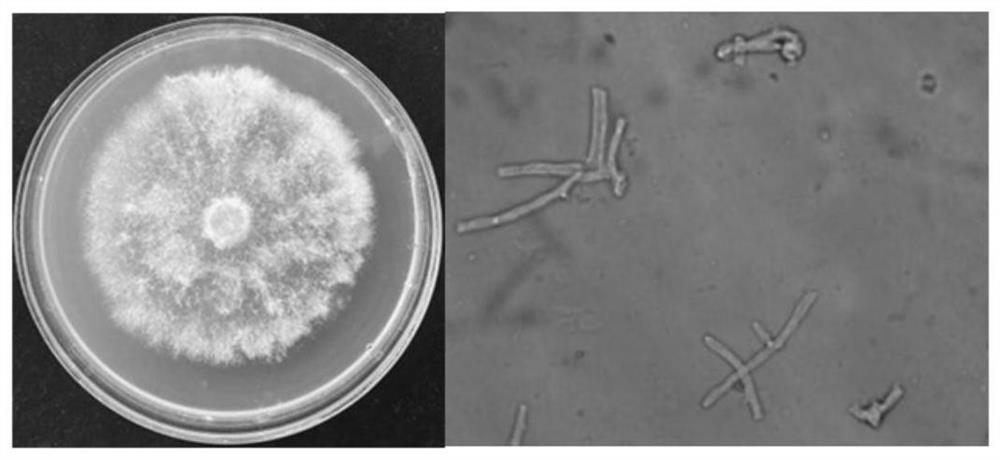Irpex lacteus LL210, application thereof and biocontrol microbial agent
A technology of Raketodon albicans, LL210, applied in the field of microorganisms
- Summary
- Abstract
- Description
- Claims
- Application Information
AI Technical Summary
Problems solved by technology
Method used
Image
Examples
Embodiment 1
[0023] Example 1 Isolation and identification of antagonistic bacteria
[0024] In the present invention, a strain of Raketodon albus LL210, which antagonizes tomato pathogenic fungi, is isolated from tomato leaves.
[0025] Select healthy leaves from diseased tomato plants for sampling, put them in sterilized ziplock bags prepared in advance, and take them back to the laboratory for separation. In the ultra-clean workbench, first wash the material in sterile water, then disinfect with 75% alcohol for 10-30s, rinse with sterile water for 3 times, then disinfect with mercuric chloride for 15s, rinse with sterile water for 3 times, and in sterile Drain excess moisture from the paper. Cut the material into square pieces of about 1 cm with a scalpel, insert the wound into the PDA medium with the wound facing down, and cultivate in a constant temperature incubator at 28°C for several days. in a 28°C constant temperature incubator for pure culture.
[0026] The morphological feat...
Embodiment 2
[0032] Example 2 Inhibitory effect of R. albicans LL210 on mycelial growth of tomato gray mold pathogen
[0033] This example verifies the antagonistic effect of Irpex lacteus LL210 on a phytopathogenic fungus, which is Botrytis cinerea Pers.
[0034] On a PDA medium plate with a diameter of 9cm, place a 0.8cm-diameter fungus cake on one side of the plate, and on the other side place a tomato gray mold pathogen cake of the same size, with an interval of 4.5cm between the two bacteria cakes , placed in a 28 ℃ constant temperature incubator, and the antibacterial rate was counted on the 7th to 14th day respectively.
[0035] The results are shown in the following table, R. albicans has obvious inhibitory effect on the growth of tomato gray mold mycelium ( figure 2 ), the antibacterial rates during 7-14 days of culture are:
[0036] time 7d 8d 9d 10d 11d 12d 13d 14d Bacteriostatic rate 64.4% 66.7% 73.3% 73.3% 81.1% 86.7% 88.9% 100%
Embodiment 3
[0037] Example 3 Inhibitory effect of H. albicans LL210 on mycelial growth of tomato late blight pathogen
[0038]This example demonstrates the antagonism of Irpex lacteus LL210 against a phytopathogenic fungus, P. infestans (Mont.) De Bary.
[0039] On a PDA medium plate with a diameter of 9cm, place a 0.8cm-diameter fungus cake on one side of the plate, and on the other side place a tomato late blight pathogenic bacteria cake of the same size, with an interval of 4.5cm between the two bacteria cakes. Placed in a 28 ℃ constant temperature incubator for cultivation, and the antibacterial rate was counted on the 7th to 14th day respectively. The results are shown in the following table, R. albicans LL210 has obvious inhibitory effect on the growth of Phytophthora tomato mycelium ( image 3 ), and the antibacterial rates during 7-14 days of culture are:
[0040] time 7d 8d 9d 10d 11d 12d 13d 14d Bacteriostatic rate 65.6% 68.9% 77.8% 82.2% 85.6% 91....
PUM
 Login to View More
Login to View More Abstract
Description
Claims
Application Information
 Login to View More
Login to View More - R&D
- Intellectual Property
- Life Sciences
- Materials
- Tech Scout
- Unparalleled Data Quality
- Higher Quality Content
- 60% Fewer Hallucinations
Browse by: Latest US Patents, China's latest patents, Technical Efficacy Thesaurus, Application Domain, Technology Topic, Popular Technical Reports.
© 2025 PatSnap. All rights reserved.Legal|Privacy policy|Modern Slavery Act Transparency Statement|Sitemap|About US| Contact US: help@patsnap.com



